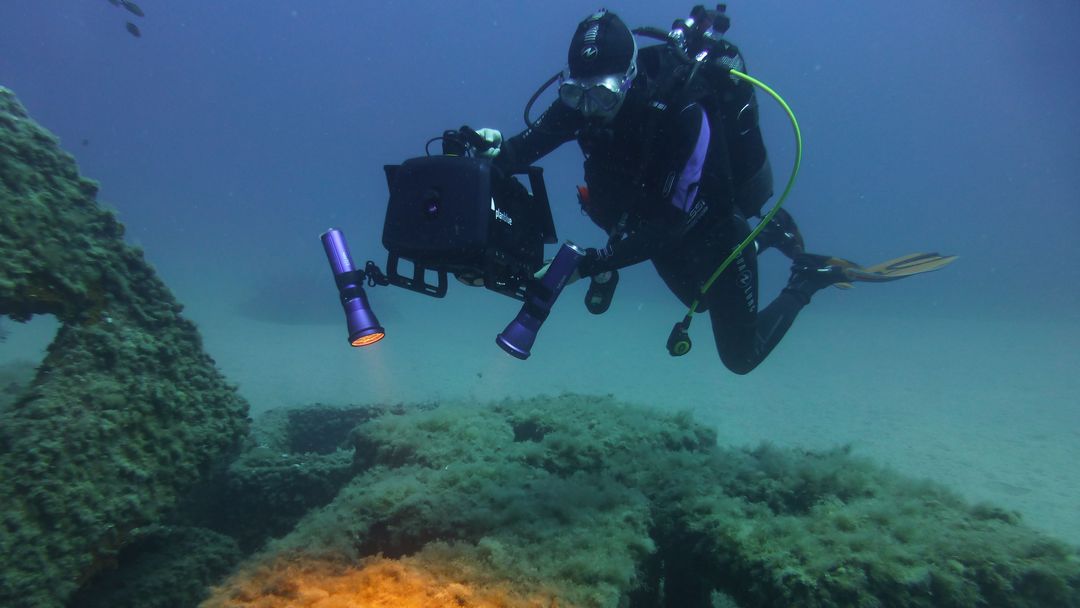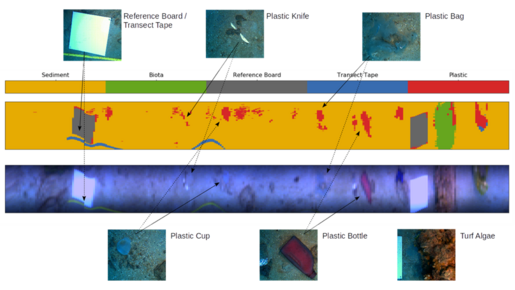Only a small part of the plastic waste in the oceans floats on the surface, the rest sinks to deeper waters or to the sea floor, threatening the local flora and fauna. So far, there is no way of detecting plastic at the bottom of the oceans on a large scale. Traditional monitoring methods, in which divers manually collect image data along lines or taut cords (so-called transects) only allow for assertions about very limited areas. In addition, these methods are highly time-consuming, expensive and close to impossible in deeper waters. Generally, they neither provide georeferenced data that can be used to find locations again, for example to recover plastic or check its condition.
Innovative monitoring technology provides important information for plastic control
A more efficient solution is required, on which a consortium from different areas of industry and research is working in the project "MtecPla"–planblue GmbH, the Robotics Innovation Center of the German Research Center for Artificial Intelligence (DFKI), Kurt Synowzik Tool and Mechanical Engineering GmbH & Co. KG and the Institute for Biomaterials and Biomolecular Systems at the University of Stuttgart. The aim is to develop an innovative monitoring technology that can automatically and extensively detect and determine plastic waste and various types of plastic on the seafloor. In addition, the new system is meant to record the condition of the plastic and link the results to georeferenced data. In this way it is not only possible to estimate the degree of contamination, but also to track changes in the plastic waste over any period of time and plan cleaning measures. In order to be able to reach inhospitable depths and cover large areas, the new system will possibly also be used by remote-controlled or autonomous underwater vehicles in the future. Thanks to automatically generated colour-coded maps, the information gained from the dives are reprehensible even without expert knowledge and is therefore of manifold use in the fight against plastic – for example for the strategy development of political decision-makers and NGOs, for drawing up guidelines and new legislation or for raising public awareness.
Hyperspectral imaging and powerful AI algorithms for precise results
To realize their project, the project partners deploy a combination of hyperspectral imaging and innovative algorithms based on artificial intelligence (AI). In each pixel, hyperspectral cameras register not only RGB colour information, but also light components in several hundred different wavelengths in the visible and near-infrared range. Thus, the so-called spectral signature of an object can be recorded, which is created by the absorption and reflection of light. Based on the characteristic reflection spectra, the algorithms can be trained to precisely recognize and classify plastic waste on the seafloor and to extract the data necessary for visual representation. The partners use so-called convolutional neural networks for this purpose - a special form of artificial neural networks that already delivers promising results in the automated recognition of plastic on water surfaces of and the sorting of plastic.
For the technology to function under water, a waterproof housing will be constructed in "MtecPla", which is meant to ensure that the light reaches the camera in the best possible way. A strong and effective corrosion protection combined with a low weight are additional requirements that the housing is meant to meet. Another challenge is the uncertainty in data collection. When scanning the bottom of the sea, for example, partial maps in the shape of strips are created, which must then be put together. It is important that no information is lost between the strips, otherwise incomplete maps would be produced. To avoid this, the partners are developing a new type of mission and path planning procedure that plans the images with regard to complete sensor coverage, automatically calculates dive paths and detects the lack of data in order to return to inadequately recorded areas.
Test campaigns in the laboratory and under real conditions for a wide range of fields of application
The developed components are first tested and evaluated in the project with already identified types of plastics as well as specially prepared sediment plastic mixtures under controlled laboratory conditions. For this purpose, a 20 m³ water basin at the Robotics Innovation Center of DFKI is used, which can be darkened and clouded to create seabed-like conditions. The new system will then be tested outside the laboratory at the bottom of a lake. Thus, the technology developed within the project can later be transferred to plastic detection in all aquatic environments. In addition, completely new fields of application arise, for example in the field of monitoring underwater structures such as offshore wind farms, aquacultures and coastal construction. The software can also be used to process hyperspectral images outside of water.
The project "MtecPla" is funded by the Federal Ministry for Economic Affairs and Energy (BMWi) within the ZIM cooperation network "Plastic Monitoring in European Waters - PlaMoWa Europe" from August 1, 2020 until October 31, 2022.
Project partner and main focus of the project:
- planblue GmbH (Coordinator) - Development of the recognition software
- German Research Center for Artificial Intelligence GmbH, Robotics Innovation Center - Development of a mission planning
- KSW - Kurt Synowzik Tool and Mechanical Engineering GmbH & Co. KG - Development of the underwater housing
- University of Stuttgart, Institute for Biomaterials and Biomolecular Systems, Research Unit Biodiversity and Scientific Diving - Comparison/Feedback/Optimization
- GlobalGreen InnoTech GmbH - ZIM Network Management Facility for PlaMoWa Europe
(Joint press release of the project partners)


